Four steps to developing effective global leadership

By Jean Lee
Innovation is the cornerstone of our times, posing a significant task for enterprises, cities, and nations seeking to draw in innovative talents. To do this, they must foster an environment that encourages globally minded and culturally sensitive leadership.
Singapore can offer an instructive example here. In the 2023 Global Innovation Index (GII), Singapore ranked fifth in global innovation and topped innovation inputs worldwide. According to the 2022 Global Talent Competitiveness Index survey, Singapore is also the second-most talent-competitive country in the world, ranking first in the Asia-Pacific region, with a business-friendly environment that has lured multinational corporations and innovative companies from across the globe to set up their Asia-Pacific headquarters or R&D centres there. Now, Singapore is the country with the most MNC headquarters in Asia.
The country exemplifies success in a few critical areas: first, its robust innovation ecosystem; second, its open and East-West integrated environment; third, its high attractiveness to international talents; and fourth, its cross-cultural and multicultural diversity. In doing so, it offers valuable lessons for how companies and countries can strive to develop culturally intelligent leadership and, consequently, drive innovation.
Leadership Requires Global Mindset & Cultural Intelligence
Simply put, effective cross-cultural talent management means managing people from diverse cultural backgrounds effectively. To build an international talent hub, we must cultivate global mindset.
Global mindset refers to an individual’s ability to understand and adapt to multicultural environments, ideas, and business practices around the world. It involves an open and inclusive attitude towards different cultural norms, values, and business models. Individuals with global mindset can connect and cooperate effectively in an increasingly interconnected and interdependent world. This encompasses global business acumen, openness to diversity, global leadership, and cultural intelligence.
Leadership encompasses three quotients: IQ (intelligence quotient), EQ (emotional quotient), and CQ (cultural intelligence quotient). IQ primarily involves cognitive abilities in areas like mathematics, language, and logical reasoning, emphasising academic and cognitive task performance such as problem-solving and reasoning skills. EQ refers to one’s ability to understand, manage, and deal with their own and others’ emotions, focusing on interpersonal relationships, self-awareness, self-management, and social skills. CQ reflects a person’s capability to interact, collaborate, and adapt in cross-cultural environments, emphasising cultural sensitivity, cross-cultural communication, and the ability to adapt to different cultural backgrounds.
For companies to be truly innovative, they must foster collaboration among people from diverse backgrounds, where collaborative and inclusive abilities are a true test of one’s cultural intelligence.
The concept of cultural intelligence was introduced 20 years ago by Professors Christopher Earley and Soon Ang from Nanyang Technological University in Singapore. It refers to one’s ability to interact effectively with culturally distinct individuals across multicultural contexts. Theoretically, it consists of three facets, which are cultural knowledge (recognition of the existence and differences of other cultures), cross-cultural skills (skills learnt from social experience; ability to appreciate critical differences between oneself and others; ability to relate with culturally different individuals; and being able to adapt behaviour appropriate to the particular cultural situation), and cultural metacognition (the cognition and acuity of experiences and strategies in the specific domain of culture) that reflect the higher-level latent factor.
Cultural intelligence has a broad impact on management in global and diverse business environments. It helps managers better understand and respect different cultures and improves their cross-cultural management ability. Specifically, cultural intelligence enables managers to:
- communicate and collaborate more effectively with employees, partners, and customers from different cultures
- formulate and execute global business strategies across different cultural contexts
- adjust leadership styles to adapt to different cultural environments
- understand and resolve conflicts to foster team collaboration
- recruit, train, and retain talent effectively by taking employees’ cultural differences into account
- blend ways of thinking from different cultures to generate more diverse perspectives and solutions
- adapt and integrate into different cultural settings more quickly
Cultural Cognition is Vital to Global Leadership
Years ago, I conducted a training program for the company Michelin. As the group’s Asia-Pacific headquarter, Michelin Shanghai needed to manage operations across more than ten countries, including South Korea, Japan, India, Malaysia, and Indonesia. However, the top management team had identified a pronounced gap in cultural understanding, which notably compromised the effectiveness of their management practices.
After conducting research, my colleagues and I proposed two concepts influencing cross-cultural management. First, global identity, which refers to an individual’s sense of belonging to the broader global international community, and a sense of affinity with people from across the world. Second, relative cultural status, a result of the fact that everyone has a “mental map” (stereotypes) of people from different cultures. In a multicultural team, team members also have certain expectations and assumptions towards leaders from different cultures.
Multicultural teams are made up of members with very different cultural and functional backgrounds, who also have different assumptions about how to approach relationships and make decisions. Newly developed global organisations and teams often struggle to balance global and local perspectives. In cross-cultural teams, members tend to judge the influence of others based on their relative cultural status. This social judgment of cultural status affects whether they will be viewed as an effective leader by multicultural team members.
Cultural Identity
We later conducted another study, surveying managers from various cultural backgrounds worldwide. We divided cultural identity into global identity and country identity. Country identity indicates one's sense of belonging to their own nationality and sees the country’s successes and failures as one’s own experiences. It focuses on the country’s unique culture, history, and social organisations, and one’s involvement in social and political activities. Global identity, on the other hand, refers to an individual’s sense of belonging and identification with the group (e.g., a multicultural team) in a cross-cultural work environment. By adopting practices, styles, and information that are part of the global culture, global identity facilitates communication between members of different cultures. The strength of an individual’s global identity will affect the intrinsic motivation to interact with people of different cultures – the extent to which individuals can adapt to cross-cultural environments is related to their identities.
When leading a cross-cultural team, a leader’s global identity positively correlates with their leadership effectiveness, whereas a strong country identity tends to negatively impact their leadership effectiveness. This underscores the importance for leaders in multicultural contexts to embrace a “global citizen” perspective, fostering an inclusive approach that values the diversity of various cultural groups.
Relative Cultural Status
Cultural status refers to cultural prestige in the eyes of others, while relative cultural status depends on the comparison of groups in a particular society or environment.
Cultural background affects interpersonal relationships and shapes how people see themselves and others. Cultural background is often associated with stereotypes and discrimination. Differences in cultural backgrounds also affect members’ expectations and assumptions of leaders’ behaviour and performance. Therefore, understanding differences in relative cultural status between members and leaders in cross-cultural teams helps us to understand challenges in cross-cultural management, and foster inclusiveness and justice within the organisations.
If we combine global identity and relative cultural status, we can categorise global leaders into four types.
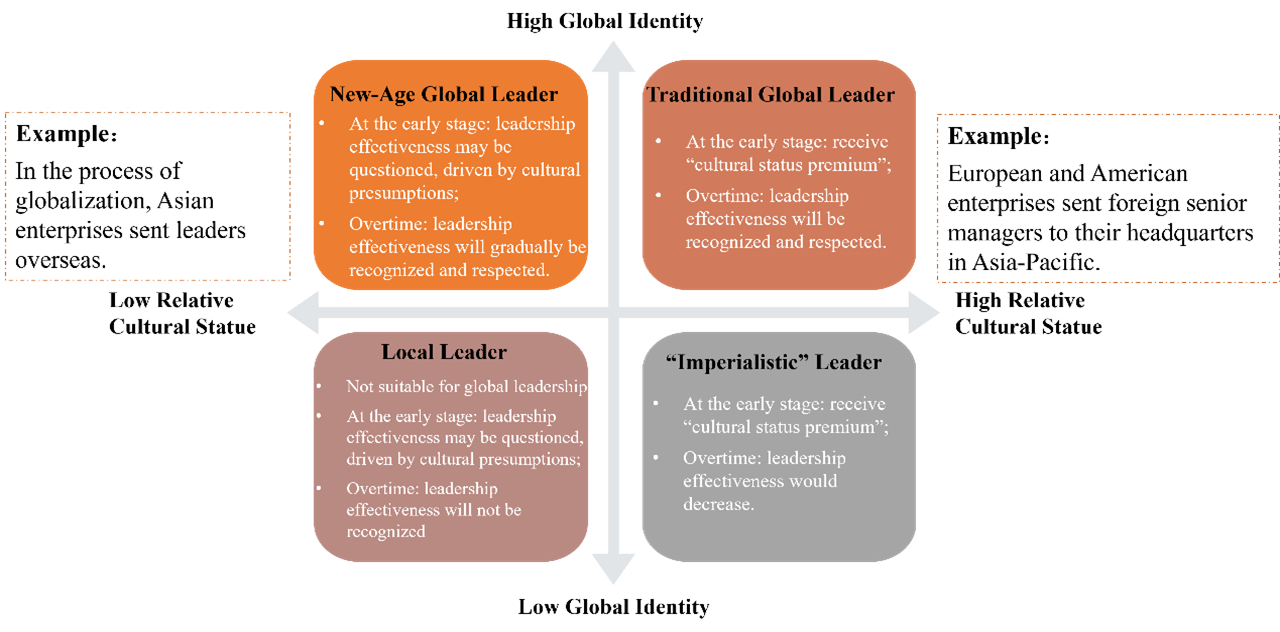
Based on this grouping, we can make the following assertions. First, an effective global leader or cross-cultural team leader must possess a high level of global identity to demonstrate respect when interacting with people from different cultural backgrounds, and to mix well with those who possess diverse cultural perspectives.
Second, even if a leader has a high level of global identity, they must also be aware of their relative cultural status in the eyes of others. When leading those with a relatively higher cultural status, the leader should be a good listener and lower their authority, and help employees to shine. On the other hand, when leading those with a relatively low cultural status, the leader should not be overly modest but should be proactive and visible, and dare to speak up to establish their own opinions.
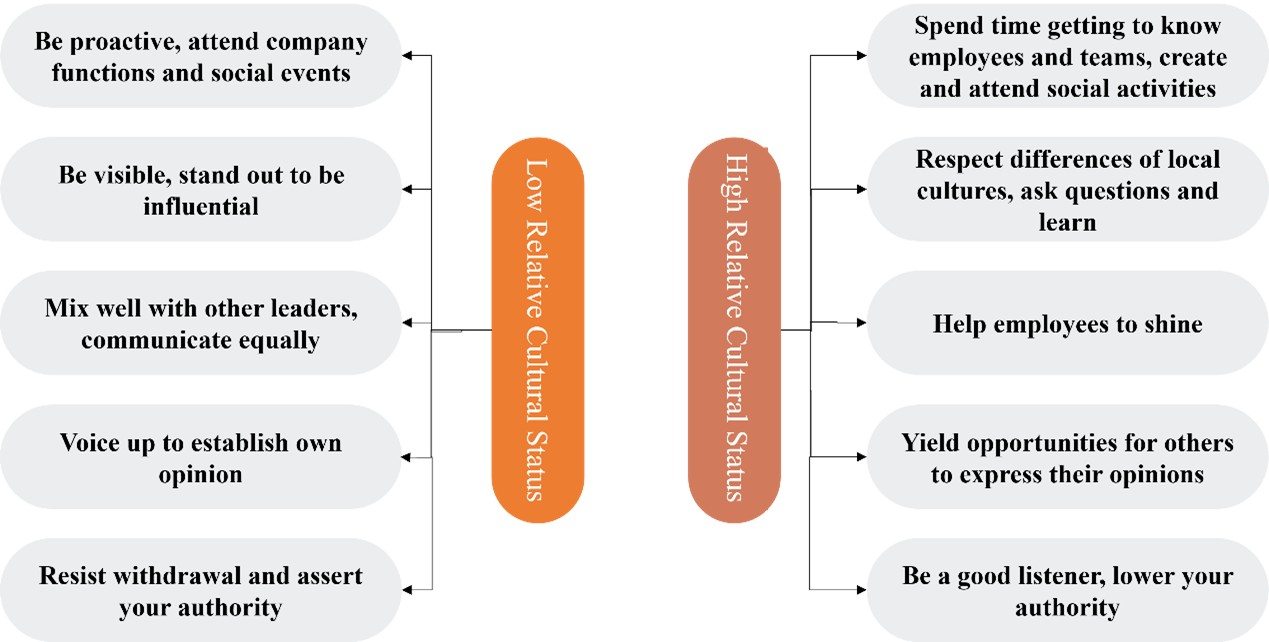
“Cultural Dimension” Influences Daily Operations of Businesses
The theory of “cultural dimension” was proposed by Dutch sociologist Geert Hofstede. It constitutes a knowledge framework centred on cross-cultural communication, depicting the effect of deep-rooted culture on the values of its social members. Understanding different perspectives on how business issues are viewed in different cultures can help managers understand and succeed in international business markets.
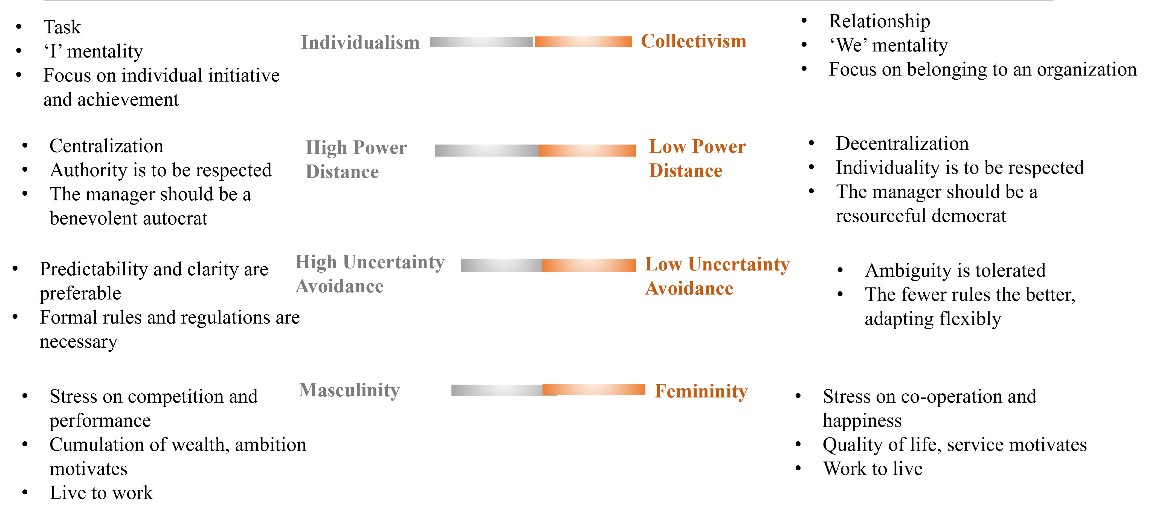
Cultural dimension influences the daily operations of businesses, including reward systems, organisational structures, and self-esteem considerations.
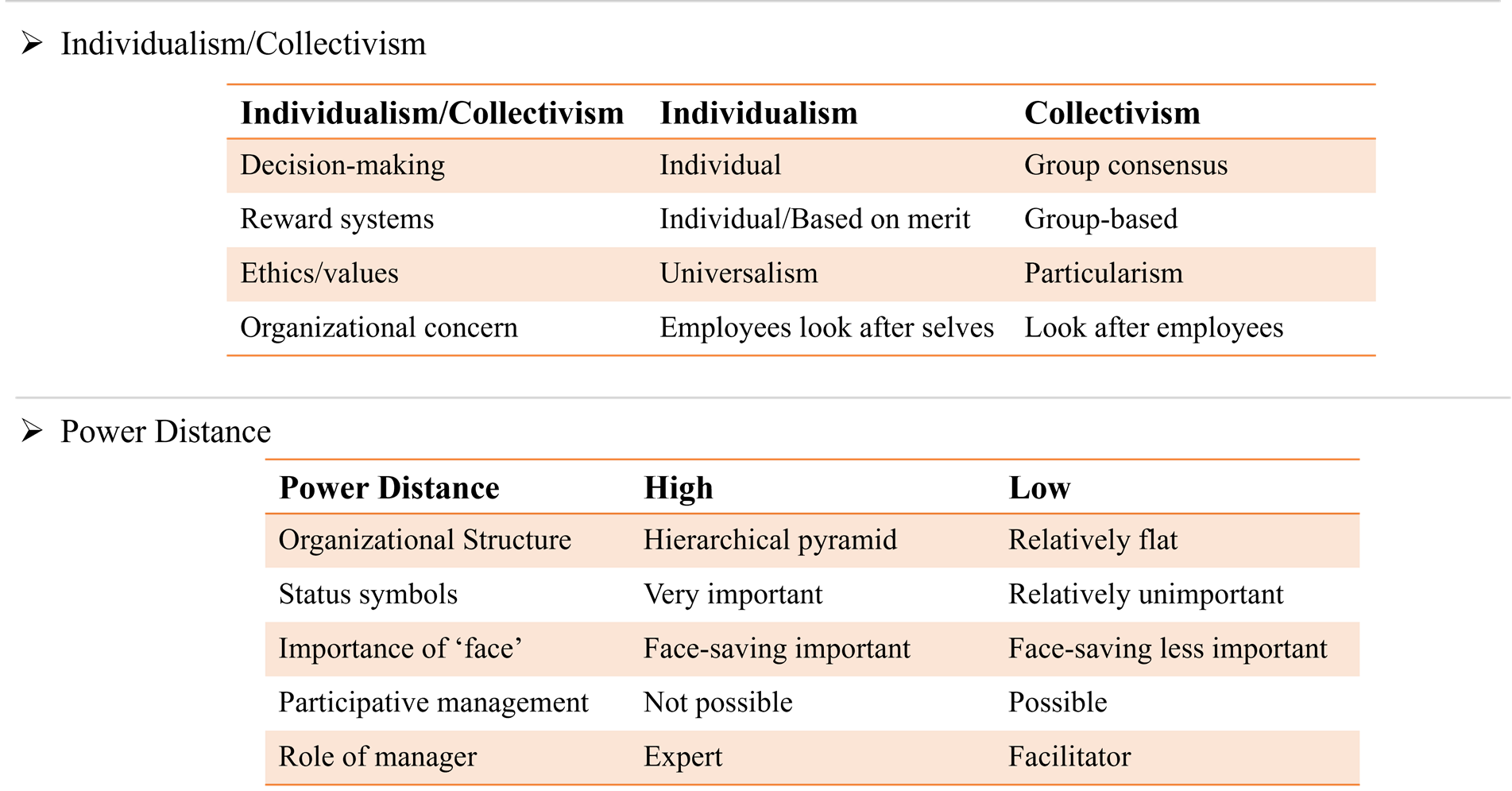
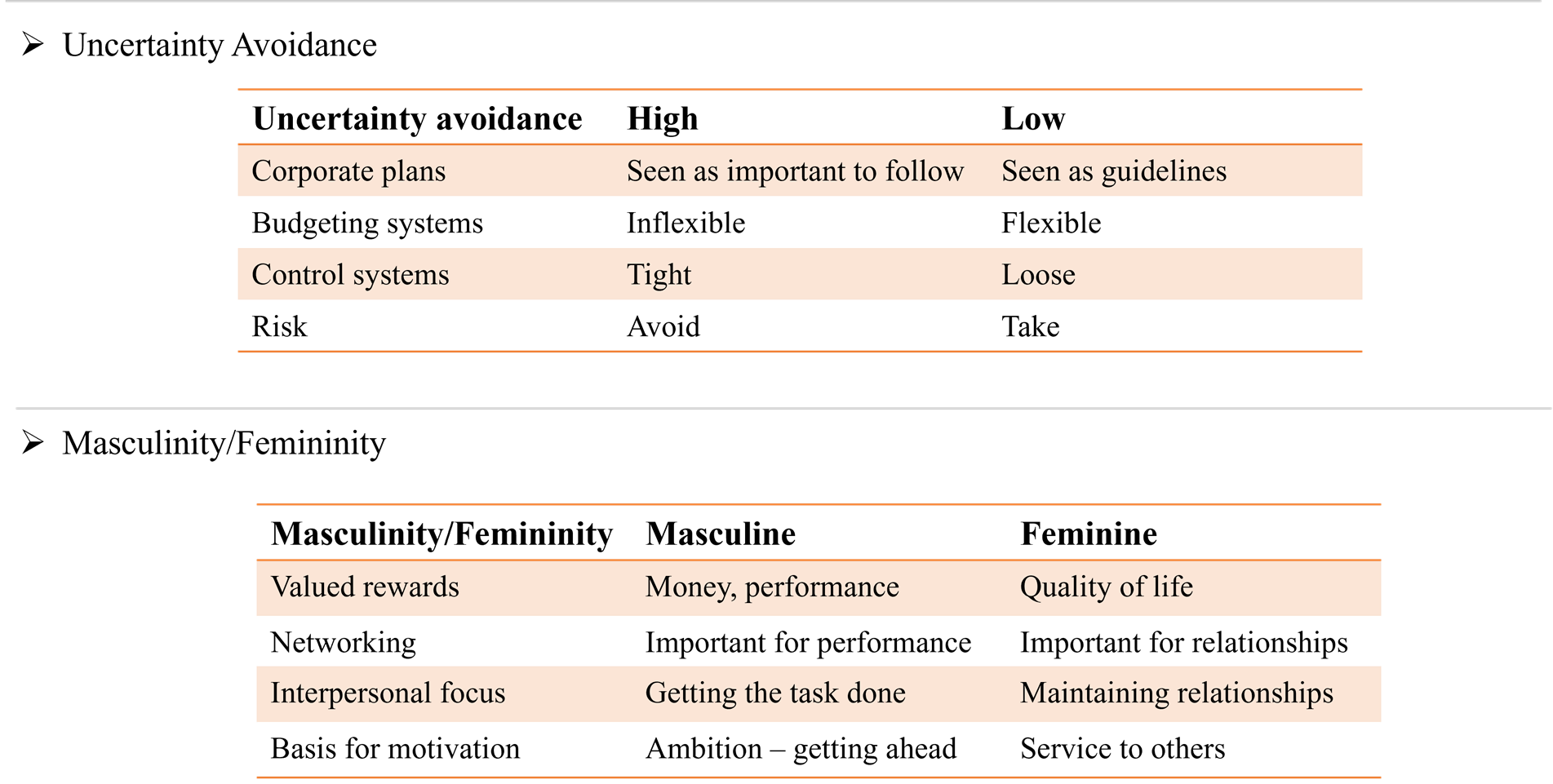
Cross-Cultural Leadership Must be Actively Promoted
With the advent of globalisation, more and more multinational organisations (MNOs) have begun to emerge, which requires more global leaders with a global mindset, global business acumen, and high cultural intelligence. This is also the case for Chinese companies, who must reflect on how to acquire and cultivate potential global leaders and lead multicultural teams effectively on their way to expanding overseas and becoming truly global companies. To seek true global leaders, businesses should focus on the following factors.
First, identify individuals with a high level of global identity. Global identity is an important factor in leadership effectiveness, and should be taken into consideration in selecting candidates for global roles. Second, relative cultural status has an important bearing on cross-cultural management. Leaders with low relative cultural status need to be more proactive, influential, and more visible to have their voices heard. Third, “cultural dimension” influences organisational behaviour and management decisions. Companies should foster cross-cultural training to improve cross-cultural recognition and skills.
From the standpoint of leadership development, it’s crucial for companies to actively support their employees in acquiring cross-cultural competencies through practice, including opportunities to work or travel abroad, or working with expatriate colleagues to broaden their cultural understanding and contribute to team diversity. Additionally, assigning executives with cross-cultural experience as mentors or coaches can provide valuable insights and guidance. Companies should also focus on nurturing high-potential leaders and helping them to expand their cognitive complexity. This will equip them to appreciate and integrate diverse viewpoints, opinions, and experiences more effectively to build an inclusive organisational culture.
Jean Lee is Professor of Management and Michelin Chair Professor in Leadership and Human Resources Management at CEIBS.













